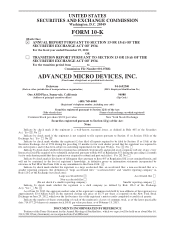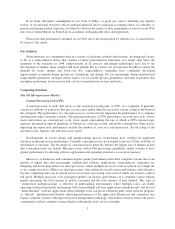AMD 2012 Annual Report Download - page 14
Download and view the complete annual report
Please find page 14 of the 2012 AMD annual report below. You can navigate through the pages in the report by either clicking on the pages listed below, or by using the keyword search tool below to find specific information within the annual report.Desktop. Our APUs for desktop PC platforms consist primarily of the AMD A Series APU and the AMD
E-Series APU. We designed the desktop AMD A-Series APU for mainstream desktop platforms, and it is
available primarily in quad- and dual-core versions with a variety of discrete-level graphics configurations. We
designed the desktop AMD E-Series APUs for essential desktop tasks, and it is available in dual-core versions
with a variety of graphics configurations. In May 2012, we launched our next generation AMD A-Series APU for
desktop PCs, small form-factors and home theater PCs. In June 2012, we introduced our next generation AMD
E-Series APU for desktop PCs. Our second generation AMD E-Series and AMD A-Series APUs have increased
x86, graphics and multi-media capabilities. In October 2012, we introduced the second generation desktop AMD
FX processors based on the “Piledriver” x86 multi-core architecture, which come in eight-, six- and quad-core
versions. We designed the AMD FX processors for multitasking, high resolution gaming, and HD media
processing. Also in October 2012, we introduced our latest quad- and dual-core AMD A-Series APUs for
mainstream desktop platforms, codenamed “Trinity” with the “Piledriver” x86 multi-core architecture.
Our CPUs for desktop PC platforms also consist of the following: AMD FX processors based on the
“Bulldozer” and “Piledriver” x86 multi-core architecture, which are available in quad- and dual-core technology,
AMD Athlon II processors, which are available in quad-, triple- and dual- core versions, and AMD Sempron
processors, which are available in limited quantities and in select regions.
Embedded Processor Products
Our embedded products address customer needs in PC-adjacent markets. Typically, our embedded products
are used in applications that require high to moderate levels of performance where key features include low cost,
mobility, low power and small form factor. High performance graphics are increasingly important in many
embedded systems. Customers of our embedded products include vendors in industrial controls, digital signage,
point of sale/self-service kiosks, medical imaging, set-top box and casino gaming machines as well as enterprise
class telecommunications, networking, security, storage systems and thin-clients, or computers that serve as an
access device on a network.
The embedded market has moved from developing proprietary, custom designs to leveraging the industry-
standard x86 instruction set architecture as a way to reduce costs and speed time to market. Customer
requirements for these systems include: very low power for small enclosures and 24x7 operation, support for
Linux, Windows and other operating systems, and high-performance for increasingly sophisticated applications.
Other requirements include advanced specifications for industrial temperatures, shock and vibration, and
reliability.
Our embedded platforms include options from the AMD Opteron, AMD Athlon and AMD Sempron
processor families; the AMD Embedded G-Series, which is the embedded version of our APUs; the AMD
Radeon™graphics processor family; and numerous AMD chipsets. These products are part of the AMD
Longevity Program, which provides for an availability period of up to five years in some cases in order to
support lengthy development and qualification cycles and long-term life of the system in the market.
In May 2012, we launched the AMD Embedded R-Series APU designed for mid- to high-end graphics-
intensive applications such as digital signage, casino gaming, point-of-sale systems and kiosks, as well as
parallel-processing-intensive applications spanning medical imaging and security/surveillance. The AMD
Embedded R-Series APU combines the new “Piledriver” architecture, with discrete class AMD Radeon™HD
7000 series graphics that support Microsoft®DirectX®11 (DirectX 11).
Chipset Market and Products
A chipset is the set of components that manages data flow between a processor (or processors), memory and
peripherals (such as the keyboard, mouse, monitor, hard drive and CD or DVD drive). Chipsets perform essential
logic functions and balance the performance of the system and aid in removing bottlenecks. Chipsets often
6
























